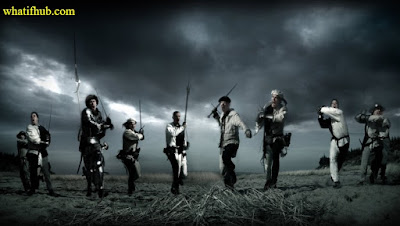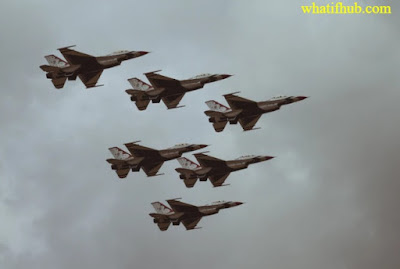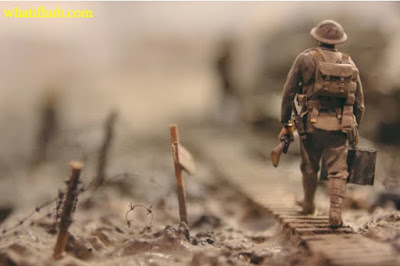
An Alternate History: What if America Had Invaded Japan? (Operation Downfall)
War is messy. Even if a conflict end decisively, there’s always destruction left behind.
What if America Had Invaded Japan? (Operation Downfall):
 |
| What if America Had Invaded Japan? (Operation Downfall)- whatifhub.com |
In Europe, Hitler’s inability to surrender only prolonged the inevitable. This determination to hold on to power backfired. When the Easter front broke, and Germany retreated. There wasn’t mercy on the Russian side.
The Russians raped, murdered, and deported millions of people As they moved on to Berlin. This is what happens in modern war. Everything is affected because the scale of the conflict isn’t limited to just fields.
Its entire cities, economic zones, population centers. Because the Nazi’s didn’t surrender, the outcome of the war came through bloodshed.
Millions more died, the Soviets claimed land for themselves, and Europe was divided. We didn’t see this after the surrender of Japan.
As we’re taught in school, the Pacific War Strategy was pretty simplistic:
America retook each island occupied by Japan, destroying most of the Japanese fleet in the process, then, just in time, drop the atomic bomb to end the war; two, for good measure :3 And, somewhere, the Soviets invaded Manchuria.
No matter your opinion on the end of the war we’re left with the ramifications of the short end to the conflict. The rebuilding of Japan was quick, and the country has become one of America’s closest allies.
The formerly isolationist empire is now one of the largest economies in the world, and a first world, democratic nation. But there was a chance that it might not have ended up this way.
Even though two bombs were dropped, and the Soviets invaded Manchuria, the only event that truly mattered was the single decision to surrender by the Japanese emperor.
What if operation downfall happened:
 |
| what if operation downfall happened- whatifhub.com |
Japan had attempted to surrender earlier, but their conditions were deemed unacceptable by American standards. To the Japanese, they feared the whole surrender was a threat to the Emperor’s life.
In our timeline, after the shock of two nuclear blasts and a Soviet invasion of Manchuria, Japan bent the knee But in an alternate timeline?
If the nukes were never dropped and the Soviet threat wasn’t really fully realized by Japan?
The Emperor could simply.. never surrender. If this was the case, the US was ready to use all the force required to bring them down. Even if that meant American boots in Japan.
This was Operation Downfall; A very real, very possible, worst-case scenario, crafted by the US military in case the Japanese refuse to surrender. A complete invasion of the Japanese homeland.
Requiring a fleet and force larger than that of D-Day. So what if, in an alternate timeline, the Japanese didn’t surrender?
Say, the Manhattan Project was behind and didn’t produce a workable bomb by August. This opens the door for a darker strain of events that would bring World War II to a longer, grinding, and more tragic conclusion.
Operation downfall alternate history:
 |
| operation downfall alternate history: whatifhub.com |
Now, when discussing Downfall, it’s important to note this was a worst-case scenario. If an action was needed to torch the foxhole on a nationwide level, this was the plan that was needed to do it.
This scenario is only if every action taken by both sides brings each other closer to an inevitable conflict in Japan. (Incoming context warning!) But! Before discussing any of that, we need to catch up on some history. (Flashback!)
In 1943, FDR deemed that the only way to truly win the battle was a policy of “Unconditional Surrender” against the Axis Powers.
This was used as a way to stamp out the militaristic elements from the governments of the nations who lost. To the Japanese, this concept was terrifying.
Many imagined what scenarios would happen if they were at the whim of an American victory.
Would the Emperor be executed? Would the Imperial code be thrown out?
In the Japanese Military code, surrender was, literally, not an option. By this time, the Japanese homeland had been obliterated from years of war.
Air domination by the US had allowed for the constant firebombing of cities, leaving millions homeless, and hundreds of thousands dead. After fighting in Europe, and island hopping, the US was tired of war.
Invasion of Japan alternate history:
 |
| invasion of Japan alternate history: whatifhub.com |
Another stage of the conflict was the last thing the Americans wanted. The outcome of the following months rested entirely on the shoulders of a few powerful figures in Japan.
Yes, there were attempts to get a conditional surrender by a few in the government. However, what was explicitly wished for was that the Emperor was to stay in power.
Other than that, the scale of these negotiations varied. From wishing for the government to remain untouched. For Japanese war trials You know, like the rape of Nanking, to be done by Japan.
And, for there to be a limited occupation of the Japanese homeland, including very small American presence in Tokyo. This was, of course, totally unacceptable to the Americans.
Unconditional surrender was the only alternative. But, with heavy casualties on both Iwo Jima and Okinawa, It became clear to the US that more were going to die to achieve this goal.
So, there were two choices to break the Japanese. One: surround Japan and blockade the entire island. This would create famines which would leave millions of civilians dead, and perhaps, after months of starvation, Japan would surrender.
The second was Operation Downfall. It would be, at least, a six-month endeavor to clear out resistance in Japan, even though Japan’s cities were destroyed, its navy obliterated, and air force obsolete. Japan still could be able of one thing: Guerrilla war.
Oh wait, wait wait! Before we get to invasion or starvations, certainly, the Emperor would have intervened by now and surrendered.
Right? Well, that’s true. But we have to consider about why did the Emperor surrender. There were two factors: Nuclear bombs and Russia. And Russia FAR outweighed the nuclear bombs.
As much as most Americans hate to say. For the whole war, Japan and the Soviets never attacked each other. Japan even had an embassy in Moscow and repeatedly tried to call for surrender, under their own terms, of course, by negotiating through Russia.
In August 1945, this relationship broke down. The Soviets felt fearless and invaded Japanese-occupied Manchuria on August 9th. The same day Nagasaki was bombed.
This wasn’t a small border skirmish, this was a complete invasion. A million and a half Soviets versus the dwindling Japanese occupation force.
The Japanese lost the entire force of 700,000 men in two weeks. Either killed, deserted, or captured.
The invasion of Japan alternative to the bomb:
 |
| the invasion of Japan alternative to the bomb: whatifhub.com |
This sudden loss scared the Japanese to think that prolonging the war would just put them in the hands of communists. And if there was one thing the Communists didn’t like, it was a religiously divine autocratic leader.
The Americans, by comparison, the Japanese hoped were a better shot to maintaining the emperor in some form. And that gamble paid off as the Americans supported Hirohito to rule, fearing rebellion.
So, in this alternate timeline, for Operation Downfall to go through, the Japanese emperor would need to not surrender in the face of both a Soviet and American invasion.
This is practically suicide by this point. But if he doesn’t surrender, then he simply allows his military to continue their plans and Japan would be an industrialized guerrilla force.
What exactly did Operation Downfall consist of?
The manpower comprised mostly of American troops but also supported by British and Australians. Japan is mountainous, with pockets of civilization in the valleys below.
Taking these cities means the military still has to out Japanese defenses in the rural mountains. Scaling high terrain to destroy zealous troops inside the mountain bunkers.
On November 1st, 1945, or X-Day, Downfall begins. It was split into two operations; the first was Operation Olympic: the invasion of Kyushu, the southernmost island.
If the Allies took this, even a small portion, then they could have a foothold to invade the rest of Japan. The problem was: Geography x.x And there are only a few points the Americans can truly invade.
This invasion is more of a slugfest. A bombing campaign further weakens defenses, but the Japanese are still held up in underground bunkers.
The Allies invade from three points at the southernmost tip of Kyushu. The Allied forces would sail from Hawaii, the Philippines, the Marianas, and the Ryukus, respectively.
After capturing the small part of the island, the Allies, then, plan for Operation Coronet: the invasion of Honshu; or the main island of Japan.
The US would hold Kyushu for a few months. During this time, the Soviets would have enveloped the entire Korean peninsula and invaded the island of Hokkaido.
Just like in Germany, the Americans and Soviets would be invading the same country from opposite points. In this alternate timeline, it’s a practical race to Tokyo.
It’s very unlikely, by this point, the Japanese emperor wouldn’t surrender. But if he didn’t, then that means Operation Coronet would, then, take place in the next March.
A straight-up amphibious assault on the Kanto plain that the Allies, would then, fight north, and seize Tokyo. The entire specifics of the assault weren’t entirely finalized because the war ended.
But, what we do know is that it consisted of a million men. Standard aircraft carrier bombardment of Kanto would be followed by a full invasion of nearly every unit available in the Pacific theater.
All coming down onto Tokyo. After this attack, it’s likely the Japanese would be fractured and broken down. The emperor, perhaps, would be arrested, or killed. If he surrenders, then, possibly, all fighting would cease.
why was operation downfall never carried out:
 |
| why was operation downfall never carried out: whatifhub.com |
If he’s killed, then the Allies have a far greater threat on their hands. The whole aftermath of occupying Japan depends on the fate of the Emperor.
He was still the political center of Japan, and removing him would cause a practical rebellion from all sides of the Island, which the US would, then, have to put down.
This was the only cause of why we kept ‘em in our timeline. The US takes Japan. Great! ...
Now what? I can’t predict how vengeful the US would be after having to lose countless lives to take the islands.
Perhaps the military would bite its tongue and allow many of the leaders to stay for... bureaucracy’s sake. Or, the US would purge the Japanese government, suppress the culture, and punish the people of Japan for the war.
Either way, tensions between the two countries are FAR greater than in our timeline. And more energy is used to rebuild a more destroyed Japan.
In the time it took the US to invade Japan, the Soviets have already invaded Manchuria, all of Korea, and the Japanese island of Hokkaido. Placing all of them under a communist puppet regime.
So this Cold War stands off is now transferred to a divided Japan. The borders were drawn simply wherever each army invaded farthest.
In our timeline, Japan completely dismantled its military. That wasn’t because of the US. We actually wanted to reconstruct the Japanese military as a powerful ally against the communists.
It was Japan, who suffered so much shame from the loss, that it dismantled its own army to never be an aggressor again. Well, because Japan was an island, this wasn’t too much of an argument.
And the US focused on Korea instead. But in this alternate timeline, The US isn’t going to be so easy on Japan’s peace effort. The northern Japanese are Soviet puppets.
And the US would rebuild Southern Japan’s military to be a buffer against any further communist movement.
So would this play out like the Korean War, with a conflict between North and South Japan? Hard to say.
Northern Japan has a much smaller population than the South. Being cold and all. And it’s hard to say what politics would drive a war between the two.
For a sizeable amount of the Cold War, It’s likely that Japan would just be divided between North and South.
As for the legacy of the Pacific war? The invasion of Japan would be remembered in the minds of the American public.
It would be seen as the most ruthless fighting it its short, half year of combat. Casualty estimates are... ...tricky To say the least.
As many people who did the estimates had motives for the numbers, they’ve used. Death toll estimates range from 100,000 to 800,000 For comparison, the US suffered 400,000 deaths in the entire war.
These numbers would be transformative to the US public. If hundreds of thousands died just because Japan didn’t surrender, then that builds scars for generations.
It’s likely the US isn’t so forgiving against Japan after the battle. Operation Downfall would have been the most complex land invasion ever accomplished.
It would have spread the war for at least another year. And continued the fight between the two countries far after Tokyo surrendered.
Millions of Japanese probably would have died in the bombing attacks, militia movements, famines, and disease that would have come from the war.
Hundreds of thousands of Americans probably would have lost their lives and never raised families.
Thankfully, for, whatever reason, be it the bombs, the Soviet attack, or both, the Emperor surrendered when he did and spared everyone that phase of the battle.
Of course, we’ll never know, a hundred percent, what could have happened, but it’s fun to theorize. This is simply just one, a possible scenario.
What do you imagine could have happened if America invaded Japan? Say in the comments.
* This article was originally published here






